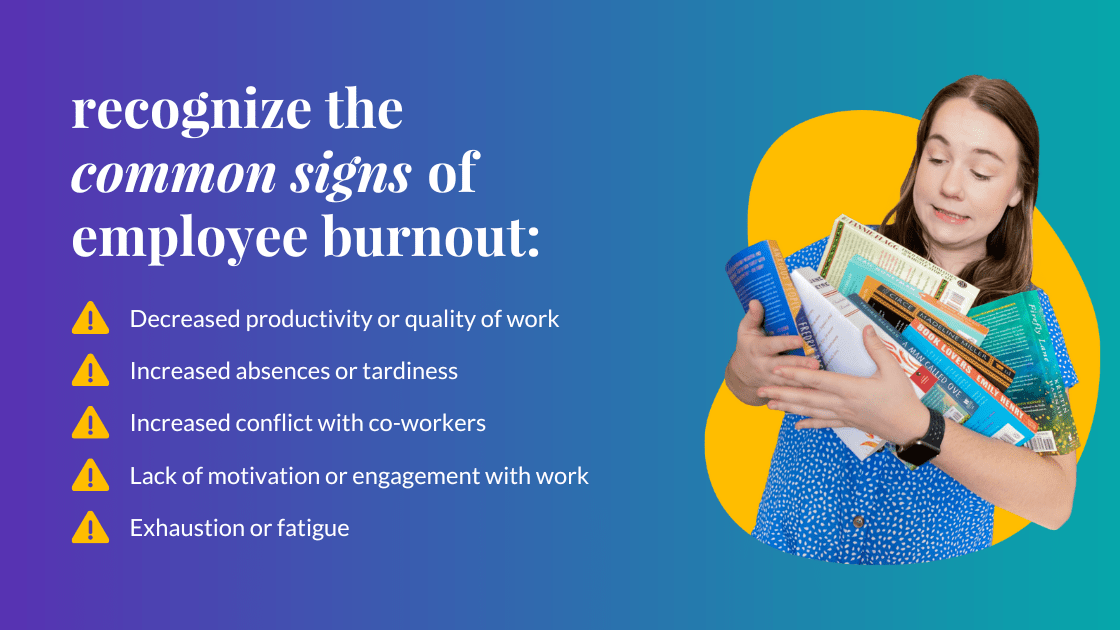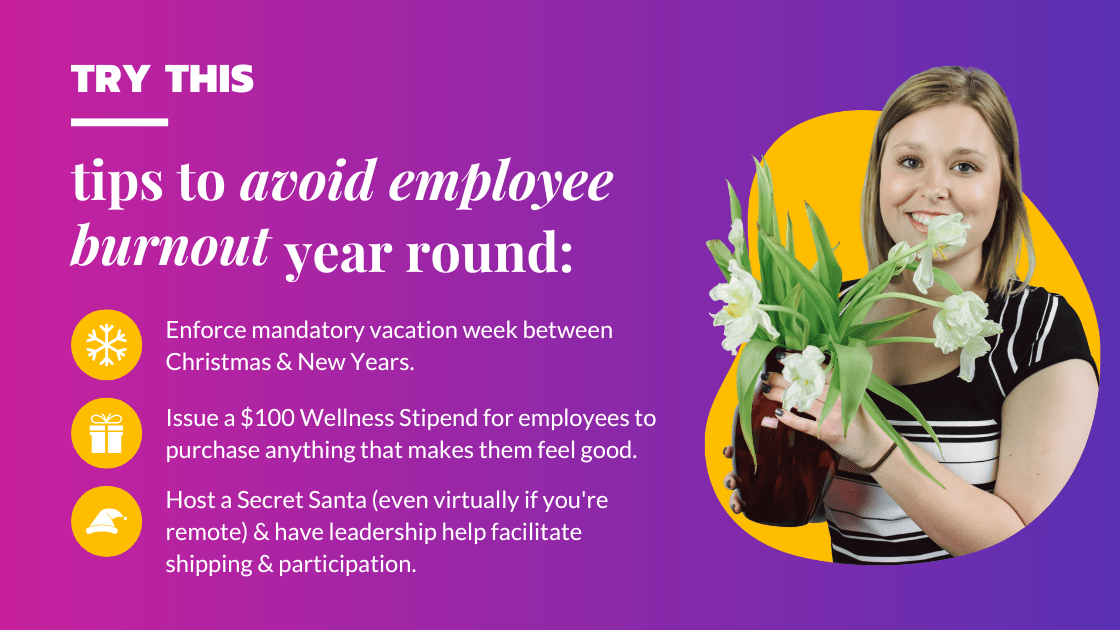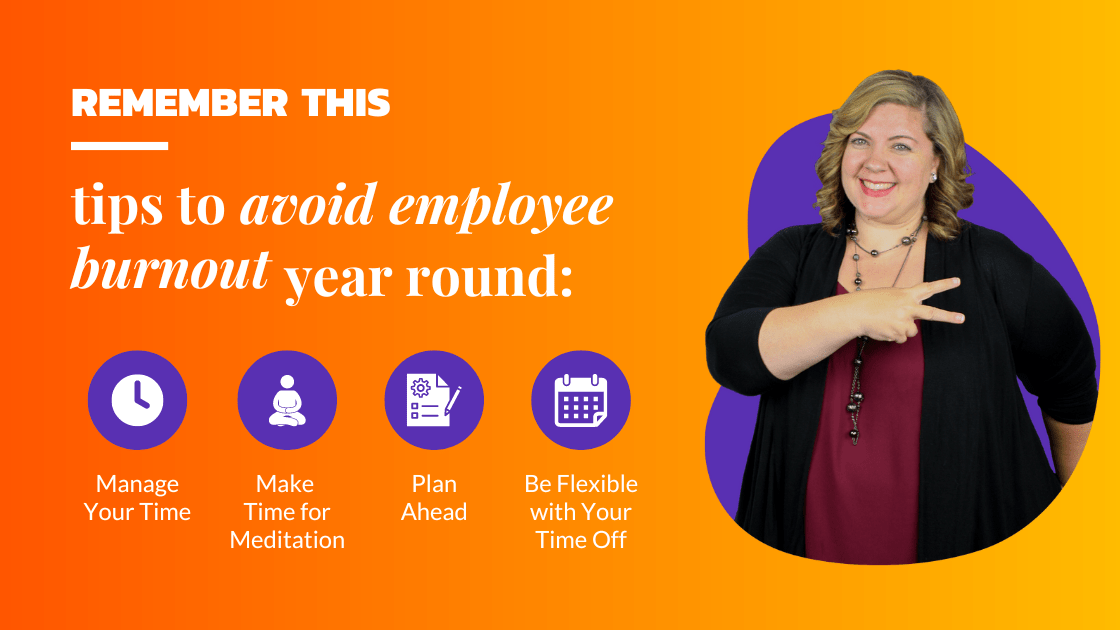As the holidays approach, many of us are gearing up for the inevitable end-of-year rush at work. For those in the marketing industry, that means long hours, lots of pressure to perform, and the dreaded risk of employee burnout. However, this holiday season, I am resolved to do things differently.
From wellness programs to flexible work schedules, several options are available to businesses of all sizes. And while it may take some time and effort to implement these changes, it will be worth it in the long run. After all, happy employees are productive employees. And that’s something that everyone can benefit from during the holiday season.
Recognizing the Signs of Employee Burnout
The first step in preventing employee burnout is to know what to look for. Here are some common signs that an employee may be experiencing burnout:
- Decreased productivity or quality of work
- Increased absences or tardiness
- Increased conflict with co-workers
- Lack of motivation or engagement with work
- Exhaustion or fatigue
If you’ve been working with the same team for a while, you know the drill: someone misses a deadline, has bursts of anger during meetings, or you see an unusual lack of participation in company activities. Chances are, your team member is feeling burnt out.
The holidays should be a time of relaxation and fun, not stressful. See what steps @RedBranch is taking to tackle holiday #burnout and keep their team on track for the end of the year: Share on XSome signs that an employee is burning out include working long hours without a break, missing deadlines, and making mistakes. If you notice any of these signs, take action immediately.
- Bursts of anger: We all have bad days, but if your team member is suddenly snapping at colleagues and getting into conflicts more often than usual, it’s a sign that something is wrong.
- Missing deadlines: If your usually punctual employee is starting to miss deadlines or hand in subpar work, it’s a sign that they’re feeling overwhelmed.
- Lack of participation in meetings: If your team member used to be the first to speak up in meetings but has become withdrawn and silent, it may be a sign of feeling burnt out.
 Getting Burntout Employees Back on Track
Getting Burntout Employees Back on Track
Schedule a one-on-one meeting with the employee to see how they’re doing. If they’re open to it, create a plan to help them recover from burnout. This might involve taking time off work, delegating tasks, or adjusting their workload.
Right Away:
- Try to identify the source of their stress. If it’s work-related, see if there are ways to reduce their workload. If the problem is personal, see if there’s anything you can do to help them manage their time outside of work.
- Encourage them to take some time off to recharge. A little bit of rest and relaxation can go a long way toward helping someone recover from burnout.
Burnout is a state of physical, emotional, and mental exhaustion caused by extended periods of stress. And it’s not just workers who are susceptible to burnout – managers and team leaders can feel it too. The good news is that there are ways to prevent and resolve burnout quickly. Burnout can be detrimental to the individual and the team, so taking action as soon as possible is important.
Encourage Open Communication
The first step in preventing employee burnout is to encourage open communication. Let your team know you’re available to talk if they feel overwhelmed or stressed. Encourage them to come to you with any concerns about their workload or their ability to meet deadlines. By creating an open line of communication, you’ll be able to identify potential problems early on and address them before they lead to burnout.
Encourage Breaks and Time Off
During the holidays, it’s important to encourage your employees to take breaks and use their vacation days. When employees are burning the candle at both ends, they’re more likely to experience burnout. So let your team know it’s okay to take a break from work during the holidays. Encourage them to use their vacation days or take advantage of company-sponsored holiday break days. And if possible, try to avoid scheduling too many meetings or deadlines during the week between Christmas and New Year’s when many people are out of the office anyway.
Make Time for Fun
Finally, remember to make time for fun! The holidays are a great time to bond with your team and build morale. Plan some holiday-themed activities or outings that everyone can enjoy. And make sure everyone has some time off to enjoy the holidays with their families and friends. Making time for fun will help prevent your team from feeling overwhelmed and stressed out this holiday season.
Practical Holiday Ideas to Prevent Employee Burnout
I am researching and implementing key employee benefits and offerings that reduce burnout among my staff. These include regular check-ins with employees to gauge their well-being, increased flexibility around work hours, and a focus on employee experience and wellness. By taking these steps, I want to create a more sustainable workplace for my team – one that is less prone to burnout and more focused on creativity and excellence.
Employee experience is important to me, and I want to ensure my team is well-rested and healthy during this busy season. To that end, I’m instituting a few old and new policies:
Mandatory Vacation Week: Everyone on my team will be required to take the week off between Christmas and New Year’s. No work emails or calls will be allowed during this time!
Wellness Stipend: Each employee will receive $100 for anything that makes them feel good – massages, gym memberships, whatever.
Secret Santa: We do a Secret Santa every year, but leadership help facilitate shipping and participation so as not to add another “thing” to the list.
 Technology Can Help Prevent Employee Burnout Too!
Technology Can Help Prevent Employee Burnout Too!
As we move into the holiday season, I’ve been thinking about ways to improve collaboration, make work more enjoyable, and get more done with less time and fewer people. One way to achieve these goals is to invest in workplace tech that can simplify employees’ day-to-day lives.
Monday.comis a great example of a tool that can help with collaboration by allowing colleagues to easily track projects and tasks. If you know RBM, you know we love us some Monday.com! It’s essentially the beating heart and (only occasionally) addled brain of our organization. Every deliverable sits there; all deadlines are tracked there, and every process is documented there. It’s essential to our work but ALSO to having conversations internally and keeping spirits up!
Ah yes, and most importantly, regarding the subject of burnout, it tracks time and time estimates, so we can plan ahead to avoid burnout, and study forensic time tracking when a Brancher feels underwater.
Jasper.ai is another useful tool that can be used to automate various tasks, freeing up time for employees to focus on more important work. While it’s no substitute for human writers (especially our amazing Branchers), it DOES help create compelling emails, enticing social updates, and (for moi anyway) it helps to organize my thoughts. As a full-service marketing agency, it’s helped tremendously with output.
Canva is a great design tool that can be used to create professional-looking documents and presentations. Although our award-winning design team can do these things in their sleep, other less-designy Branchers can use Canva Pro to quickly create blog inserts, build social media GIFs and designs, and build reports and presentations that our clients can easily access and edit when we’re not able to take on a last-minute project.
Design Pickle provides unlimited graphic design services for a monthly fee. We initially used Design Pickle and were…less than impressed. However, lately, they have really stepped up their game. The professional subscription allows us to tap a dedicated designer for last-minute projects or when we unexpectedly have a designer out sick.
MeetGeek is a call recording platform that records calls, transcribes them, listens for certain words, and notates them. All calls and transcripts stay in a central location, making it dead simple for our account managers to go back and double-check their notes after a busy day of calls. The platform even offers sentiment analysis and talk time!
Fathom is a similar tool, but it gathers all questions asked and has color-coded labels that the note taker can click quickly when they want to remember part of the call. It also tells you when you’re “monologuing,” which makes me feel like a supervillain every single time.
By investing in workplace tech, businesses can make their employees’ lives easier and help them to be more productive.
Flexibility is a fundamental part of @RedBranch’s values and approach to tackling #EmployeeBurnout. See what steps Red Branch takes to give Branchers a bit of rest as the holiday season approaches. Share on XThe Basics of Avoiding Employee Burnout All Year Round
The holiday season is a time of joy, but it can also be a time of stress for employees and employers alike. As an employee, you may feel pressure to meet deadlines and finish projects. And as an employer, you may be dealing with demanding customers and challenging workloads. Here are my top tips for supporting employees’ mental well-being during the high-stress holiday season and every season:
Time management is key. In the past, I’ve found that the key to surviving the holidays is time management. If you can, start working on projects ahead of time so you’re not feeling overwhelmed at the last minute. And if you can’t finish everything before the holidays, try to take some time off after the New Year to catch up. This applies throughout the year. The very first thing our leadership team does when someone is suffering from burnout is to go through their task list, time estimates, and time-tracked for each item. Often, we find that it’s more a matter of tracking better, estimating better, and transferring/outsourcing things outside of their strengths than actually HAVING too much work to do.
Make time for meditation. The holidays can be hectic, but it’s essential to take time for yourself to relax and recharge. Taking even 10 minutes of your day to meditate can help reduce stress and improve your mood. So give employees time to meditate or take a few minutes to themselves before starting their shift. I hear a whole lotta talk about how meetings are pointless and should be emails etc. I disagree. Every morning in our stand-ups, we ask a silly little “Would You Rather” question to get everyone comfortable. All told, it can take up to 20 minutes to get through. However, it gives people a chance to think about something less consequential than their to-do list and allows for a little Zen time before the sausage gets made.
 Plan ahead. You don’t wait until the last minute for your holiday shopping or to wrap presents, so why wait to plan at work? Try to have a plan for the holiday season. Having a clear understanding of what needs to be done and when it needs to be done can go a long way in reducing stress levels. Start planning early so that you can enjoy the holidays without feeling frazzled. Again, we do this sort of thing year-round. Our business relies on a block of time we PROMISE our clients. So when there are fewer hours, we have to get smart about how we will do that. So we’re working ahead, allowing Branchers to work across pods and teams and basically just HELPING each other to ensure our clients get what they need while we still get to have time off for the holidays.
Plan ahead. You don’t wait until the last minute for your holiday shopping or to wrap presents, so why wait to plan at work? Try to have a plan for the holiday season. Having a clear understanding of what needs to be done and when it needs to be done can go a long way in reducing stress levels. Start planning early so that you can enjoy the holidays without feeling frazzled. Again, we do this sort of thing year-round. Our business relies on a block of time we PROMISE our clients. So when there are fewer hours, we have to get smart about how we will do that. So we’re working ahead, allowing Branchers to work across pods and teams and basically just HELPING each other to ensure our clients get what they need while we still get to have time off for the holidays.
Be flexible with your time off. Try to take some time off around the holidays so that you can participate in festivities without feeling too stressed out. And if you can’t take time off, schedule some flex time for extra holiday activities. In order to take the entire week between Christmas and New Year’s off, we’ve blocked the weeks before and after for time off. In an ideal world, this would work well, but we have:
- An employee who has the opportunity to attend a wedding in India (a three-week affair)
- A Brancher needed by their family during severe health issues
- Someone who needs to travel (carefully) through the snowy Midwest to arrive at their relatives on time
Add to that the inevitable sick days, child care issues, ailing family members, disrupted travel, and for some reason in our office, pets that clearly have a death wish…you can see that some semblance of flexibility is also key. So we simply work ahead, and then when a Brancher NEEDS time to deal with life, they get it.
By being aware of the signs and taking steps to prevent and resolve burnout, you can create a happier and more productive workplace for everyone.


